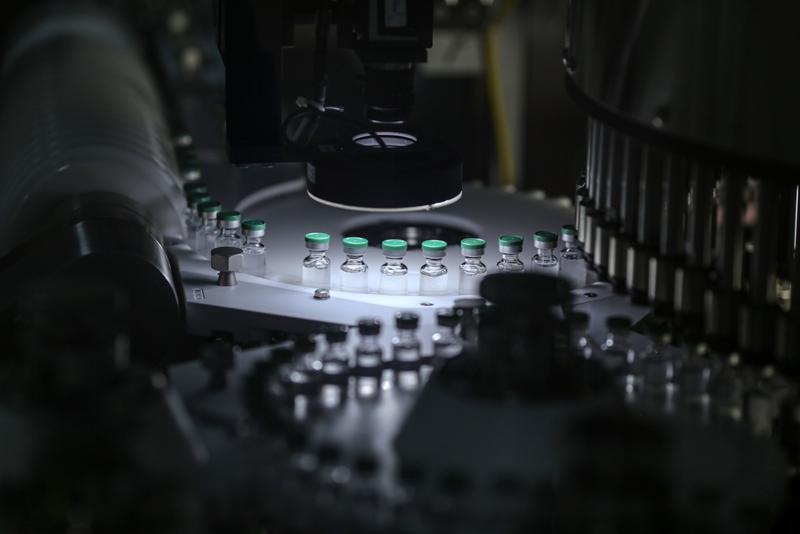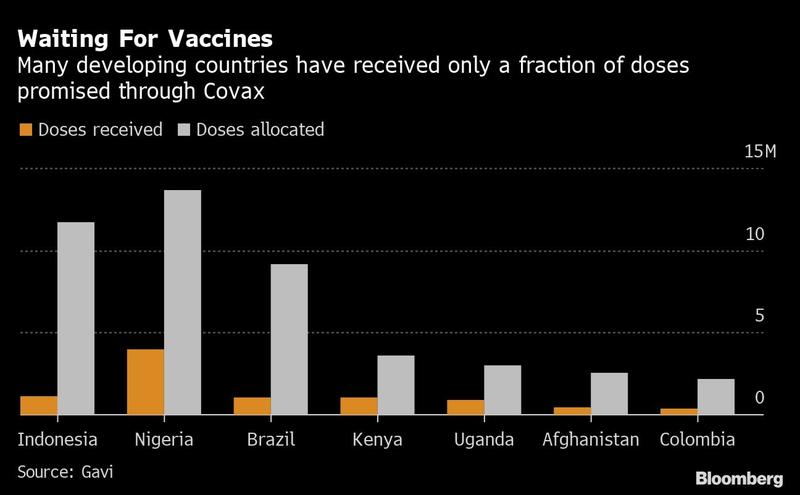 Vials of Covishield, the local name for the COVID-19 vaccine developed by AstraZeneca Plc and the University of Oxford, move along a conveyor on the production line at the Serum Institute of India Hadaspar plant in Pune, Maharashtra, India, on Jan 22, 2021. (DHIRAJ SHIGH/BLOOMBERG)
Vials of Covishield, the local name for the COVID-19 vaccine developed by AstraZeneca Plc and the University of Oxford, move along a conveyor on the production line at the Serum Institute of India Hadaspar plant in Pune, Maharashtra, India, on Jan 22, 2021. (DHIRAJ SHIGH/BLOOMBERG)
Growing vaccine nationalism in major producers like India are hitting the world’s most disadvantaged nations the hardest, leaving them waiting for millions of doses promised through a World Health Organization-backed inoculation initiative.
The plans to keep more vaccine supply for domestic use are exacerbating what the WHO’s head this week called a “grotesque” supply chasm between rich and poor nations, dealing another blow to the prospect of global solidarity in fighting the COVID-19 pandemic.
Developing nations from Kenya to Brazil - where deaths surged past 300,000 this week - have been left waiting for doses after only a fraction of those promised have been received, according to data from Gavi
The world’s biggest vaccine manufacturer, India’s Serum Institute, is a key supplier to COVAX, a program through which 2 billion vaccine doses are supposed to be distributed to middle and low-income countries, many of which have no ability to sign procurement contracts on their own.
These plans are now threatened by India’s decision to pare back shipments so that more supply can be kept for domestic use as a new wave of infections emerges and the government expands inoculation to all aged 45 years and above. Serum’s emergency license granted in early January doesn’t allow it to fulfill export orders without a nod from New Delhi.
READ MORE: WHO chief: Little done to address virus vaccine inequity
Developing nations from Kenya to Brazil - where deaths surged past 300,000 this week - have been left waiting for doses after only a fraction of those promised have been received, according to data from Gavi, the Vaccine Alliance, one of WHO’s COVAX partners. The shortfalls are mainly of AstraZeneca Plc’s vaccine, which Serum makes, not other vaccines ordered by COVAX, such as the Pfizer Inc-BioNTech SE one, Gavi’s data show.

Most of COVAX’s initial allocations of the BioNTech-Pfizer SE shot have been received by countries, the data show - though not many developing nations can handle their mRNA vaccine given the deep freeze logistical requirements.
India’s pivot mirrors the European Union’s consideration of controversial restrictions in response to criticism of its chaotic, slow immunization campaign. Both places have exported more shots than they’ve administered at home, and are now coming under domestic pressure as infections surge again - though the EU has pledged that its new rules won’t affect COVAX shipments.
Hope for vaccine equality and solidarity is imploding, said Fiona Russell, principal research fellow at the University of Melbourne and group leader for Asia-Pacific health at the Murdoch Children’s Research Institute.
“We’ve seen that already because it’s being sucked up by Europe and now India and the US, so the supply to the rest of the world doesn’t go anywhere. It’s a huge issue.”
Vaccine diplomacy
In recent months, India has attempted to burnish its global image through vaccine diplomacy. Subrahmanyam Jaishankar, India’s foreign minister, touted friendship and solidarity through “Made in India” vaccines arriving in countries from Bolivia to South Sudan to the Solomon Islands.
READ MORE: China promotes global vaccine equity
But after the country shipped or donated more than 60 million doses of COVID-19 vaccine, India’s exports have slowed to a trickle. Growing criticism of the speed of its own immunization campaign and a fivefold increase in new virus infections over the past month spurred the change, according to government officials familiar with the matter who asked not to be identified as the decision has not been publicly announced.
A domestic-focused stance is evident in the world’s most powerful economies and there are signs that vaccine diplomacy is being used to achieve government aims. The US has ordered almost enough shots to inoculate every American adult twice, and it’s still adding to its coffers
“Both these things are linked,” said Shahid Jameel, director of the Trivedi School of Biosciences at India’s Ashoka University. “At a time that a surge is happening in India, there is pressure on the government.”
Gavi said Thursday that increased demand for COVID-19 vaccines from India was behind delays in authorizing further export licenses from its main supplier, Serum.
“COVAX is in talks with the government of India with a view to ensuring deliveries as quickly as possible,” a Gavi representative said. India’s health ministry declined to comment through a spokesperson.
US, Mexico
A domestic-focused stance is evident in the world’s most powerful economies and there are signs that vaccine diplomacy is being used to achieve government aims. The US has ordered almost enough shots to inoculate every American adult twice, and it’s still adding to its coffers.
While there is no restriction against exporting shots made in the US, companies are required to fulfill their contractual obligations first, Biden administration officials have said.
Earlier this month, the US said that it plans to send 4 million doses of the AstraZeneca vaccine to Mexico and Canada, potentially its first exports.
The deal, which would send 2.5 million doses to Mexico, was floated at the same time the Mexican government agreed to crack down on the flow of migrants north through the country and to the US, where a humanitarian crisis continues to brew on the border.
“Every government is accountable to its own citizens,” said Jaspreet Pannu, a resident physician and a global health and biosecurity researcher at Stanford University Department of Medicine. “It’s very difficult for national governments to keep the global good as their main priority. It’s very tempting for national governments to break off on their own because of the ways the incentives align.”
Not enough vaccine
Since Ghana became the first country to take delivery of 600,000 COVAX-supplied shots last month, the program has distributed more than 32 million doses to 60 countries, but officials said that supply limitations are holding it back.
These shortfalls come despite the fact that globally, supply is relatively abundant. Production from 13 vaccine makers could rise to 12 billion doses by the end of the year, according to a study from the Duke University’s Global Health Innovation Center
“The problem we have quite frankly is we cannot get enough vaccine,” Bruce Aylward, a senior WHO official, said at a news conference on Monday, specifically identifying Serum and AstraZeneca as the holdups. “Right now the manufacturers are unable to keep up with our orders.”
COVAX’s troubles has left developing countries, some of which were relying entirely on the initiative to access immunizations, at a loss and scrambling to secure orders on their own.
India’s neighbor Pakistan, was in line for 45 million doses through COVAX. The first shipment, due in March, has now been indefinitely delayed, Asad Umar, the country’s planning minister, said Thursday.
ALSO READ: Vaccine disparities raise alarm as COVID-19 variants multiply
Vietnam, which had been promised 1.37 million doses on March 25, will now get 811,200 in three weeks time, said local UNICEF representative Rana Flowers.
These shortfalls come despite the fact that globally, supply is relatively abundant. Production from 13 vaccine makers could rise to 12 billion doses by the end of the year, according to a study from the Duke University’s Global Health Innovation Center. That would be enough to inoculate 70 percent of the world if distributed equally - an aim that the WHO is now struggling to achieve.
“There is such an urgent need for more balanced access to vaccines,” said Andrea Taylor, who leads COVID-19 research at Duke’s Global Health Institute. “We can’t allow a significant portion of the world to wait six months or a year or more to get vaccinated.”
“It just gives the virus more opportunities to evolve in ways that could greatly prolong the pandemic for everyone.”


